| Pages:
1
2 |
Magpie
lab constructor
    
Posts: 5939
Registered: 1-11-2003
Location: USA
Member Is Offline
Mood: Chemistry: the subtle science.
|
|
Preparation of Oleum by Use of Phosphoric Acid
November 24, 2017
A. Introduction
H3PO4 + lots of heat ---→ HPO3 + H2O
HPO3 + H2SO4 + lots of heat --→ H3PO4 + SO3
The method used is that of CD-ROM-LAUFWERK as forwarded to this forum by garage chemist.
I performed it at 10X scale.
B. Apparatus
600 mL borosilicate beaker
250 mL borosilicate rbf
100 mL rbf
distillation glassware (tapered connections)
aluminum foil and fiberglass blankets
Meeker burner on MAPP gas
iron ring
ceramic triangle or iron screen
propane bunsen burner
heat resistant clamp for rbf
MAPP gas
propane
C. Reagents
40 mLcon sulfuric acid
135 mL 85% phosphoric acid
D. Procedure
a. Preparation of HPO3
1. Set up the iron ring w/ceramic triangle or wire gauze on a ringstand at the elevation suitable for the Meeker burner. Place 600 mL beaker on the
ring.
2. Add 135 mL of phosphoric acid to the beaker.
3. Apply the strongest possible heat to the beaker with the Meeker burner on MAPP gas.
4. Intensely heat the beaker until the melt turns red or 1 ½ hrs have elapsed, whichever comes first.
5. While the HPO3 melt is still hot pour it into a 250 mL rbf (the pot).
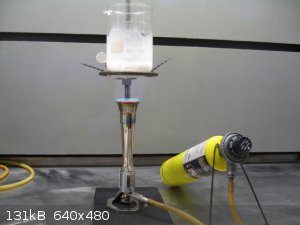
H3PO4 to HPO3
b. Preparation of Oleum
1. Pour 40 mL of con sulfuric acid into the pot holding the molten HPO3.
2. Secure the pot to a ringstand using a heat resistant clamp.
3. Place an iron ring with wire gauze under the pot.
4. Connect a stillhead (w/glass plug), condenser, vacuum adapter, and 100 mL receiving rbf to the pot.
5. Place an aluminum foil tent around the pot up to the bottom of the stillhead.
6. Wrap a fiberglass blanket around the aluminum tent.
7. Provide the condenser with 11°C water (approximately).
8. Heat the pot strongly with the propane bunsen burner. Production rate ran from 25d/min in the beginning to half that toward the end.
9. Heat until approximaly 30 mL of oleum has collected. If everything goes smoothly this will only take ≈ ½ hr.
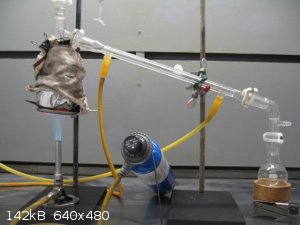
H2SO4 toSO3
E. Results
About 60g (30 mL) of 65-70% oleum will be in the pot. My yield was 62.4g. This is a 100% yield assuming 70% oleum and based on the H2SO4 charged.
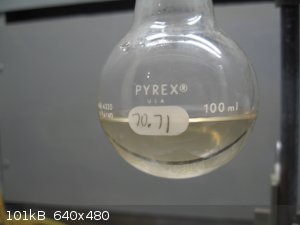
oleum product
F. Discussion
One should be prepared to deal with problems during the distillation of oleum. Here are the problems I dealt with during today’s preparation: 1)
Proper heat removal in the condenser is critical and can be a nuisance, ie, my water temperature ranged from 8°-10°C, apparently a bit too cold as
considerable oleum had frozen in the condenser. This was removed by turning off the cooling water and using a heat gun. 2) Ran out of propane. Have
a spare can available. 3) The rubber edge on my fiberglass blanket caught fire. Make sure it is out of the way of the bunsen flame. 4) Excessive SO3
was spewing out the tublature on the vacuum adapter at times. This is due to the condenser and/or receiver being too warm. Put the cooling water
back on line. With this run everything ran smoothly when the cooling water reached 14°C toward the end. A cooler temperature may be needed in the
beginning when oleum production is high.
G. Vessel Corrosion
Both the 600mL beaker and the 250mL pot become permanently corroded/etched. They are now dedicated to oleum service.
edit: All tapered glass joints (except at the receiver) are locked up. They were sealed with con H2SO4. This will keep me busy for awhile.
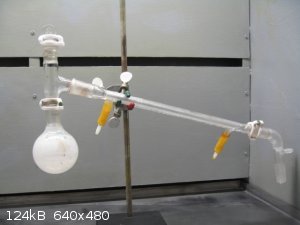
permanent phosphate etch
edit: the distillation assembly broke loose after soaking in water overnight, except for the plug in the stillhead. I have it soaking in WD-40 now.
If that doesn't work I will flame heat the female part.
edit2: The plug came loose after flaming the stillhead.
Questions, comments, and suggestions are welcomed.
[Edited on 25-11-2017 by Magpie]
[Edited on 25-11-2017 by Magpie]
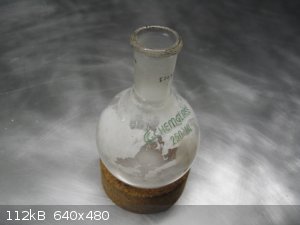 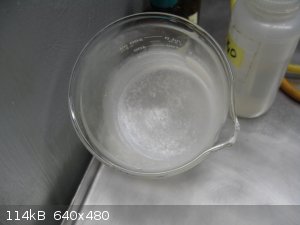
[Edited on 25-11-2017 by Magpie]
The single most important condition for a successful synthesis is good mixing - Nicodem
|
|
|
ninhydric1
Hazard to Others
  
Posts: 345
Registered: 21-4-2017
Location: Western US
Member Is Offline
Mood: Bleached
|
|
For the prep of thionyl chloride I assume? Can't wait for that! 
The philosophy of one century is the common sense of the next.
|
|
|
Magpie
lab constructor
    
Posts: 5939
Registered: 1-11-2003
Location: USA
Member Is Offline
Mood: Chemistry: the subtle science.
|
|
Yes, I have to build up large stocks of oleum and SCl2 just to make 43g of thionyl chloride, ie, 142g of 65%oleum and 135.5g of SCl2. However, I
will also get 47g of chlorosulfonic acid.
[Edited on 25-11-2017 by Magpie]
The single most important condition for a successful synthesis is good mixing - Nicodem
|
|
|
Vosoryx
Hazard to Others
  
Posts: 282
Registered: 18-6-2017
Location: British Columbia, Canada
Member Is Offline
Mood: Serial Apple Enjoyer
|
|
You've been busy 
Interesting synth. Glad you put the fact that it ate away at your glass in - that is enough to deter me from trying it with my cheap Chinese glass.
How badly was it corroded? Just "Frosted" or was there actual pitting? Do you have a pic?
|
|
|
Tsjerk
International Hazard
    
Posts: 3035
Registered: 20-4-2005
Location: Netherlands
Member Is Offline
Mood: Mood
|
|
Nice post! Could you elaborate at bit on how you mixed the HPO3 with the sulfuric acid? Or did they mix spontaneously?
|
|
|
PHILOU Zrealone
International Hazard
    
Posts: 2893
Registered: 20-5-2002
Location: Brussel
Member Is Offline
Mood: Bis-diazo-dinitro-hydroquinonic
|
|
Nice work and presentation as usual Magpie 
In principle the same procedure could be use to make valuable N2O5...wich has almost the same range of boiling point as SO3 and this is much lower
than the BP of any H3PO4 or anhydride of it...
Eventually in the case of heat sensitivity cold trap distillation under partial vaccuum may be used...
HPO3 is a kind of acid anhydride (-O-P(=O)(-OH)-)n (usually n=3 and cyclic)...this molecular skeleton is found into polyphosphates.
==> reaction could be called trans-anhydridification 
PH Z (PHILOU Zrealone)
"Physic is all what never works; Chemistry is all what stinks and explodes!"-"Life that deadly disease, sexually transmitted."(W.Allen)
|
|
|
Magpie
lab constructor
    
Posts: 5939
Registered: 1-11-2003
Location: USA
Member Is Offline
Mood: Chemistry: the subtle science.
|
|
Quote: Originally posted by Vosoryx  | You've been busy 
Interesting synth. Glad you put the fact that it ate away at your glass in - that is enough to deter me from trying it with my cheap Chinese glass.
How badly was it corroded? Just "Frosted" or was there actual pitting? Do you have a pic? |
It is frosting. I can get better pictures for you soon. What you see in my pictures is what it looks like from the outside.
I wouldn't worry about your glass as long as it is borosilicate.
The single most important condition for a successful synthesis is good mixing - Nicodem
|
|
|
Magpie
lab constructor
    
Posts: 5939
Registered: 1-11-2003
Location: USA
Member Is Offline
Mood: Chemistry: the subtle science.
|
|
Quote: Originally posted by Tsjerk  | | Nice post! Could you elaborate at bit on how you mixed the HPO3 with the sulfuric acid? Or did they mix spontaneously? |
Thank you.
I just poured it into the HPO3 very hot melt.
The single most important condition for a successful synthesis is good mixing - Nicodem
|
|
|
Magpie
lab constructor
    
Posts: 5939
Registered: 1-11-2003
Location: USA
Member Is Offline
Mood: Chemistry: the subtle science.
|
|
Thanks PHILOU
Yes, definitely an anhydride: H3PO4 ---> HPO3 + H2O
Could 6HPO3 + 6NaOH ----> (NaPO3)6 + 6H2O
This would be sodium hexametaphosphate, aka Calgon
[Edited on 25-11-2017 by Magpie]
[Edited on 25-11-2017 by Magpie]
The single most important condition for a successful synthesis is good mixing - Nicodem
|
|
|
aga
Forum Drunkard
    
Posts: 7030
Registered: 25-3-2014
Member Is Offline
|
|
Great work Magpie !
Brave too - i certainly haven't got the solid steel balls required to make oleum 
|
|
|
Magpie
lab constructor
    
Posts: 5939
Registered: 1-11-2003
Location: USA
Member Is Offline
Mood: Chemistry: the subtle science.
|
|
aga: no balls needed, only a good fume hood.
The single most important condition for a successful synthesis is good mixing - Nicodem
|
|
|
Magpie
lab constructor
    
Posts: 5939
Registered: 1-11-2003
Location: USA
Member Is Offline
Mood: Chemistry: the subtle science.
|
|
Quote: Originally posted by Magpie  | Quote: Originally posted by Vosoryx  | You've been busy 
Interesting synth. Glad you put the fact that it ate away at your glass in - that is enough to deter me from trying it with my cheap Chinese glass.
How badly was it corroded? Just "Frosted" or was there actual pitting? Do you have a pic? |
It is frosting. I can get better pictures for you soon. What you see in my pictures is what it looks like from the outside.
I wouldn't worry about your glass as long as it is borosilicate. |
Here's the pictures:
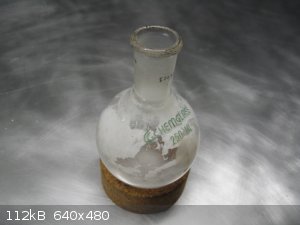 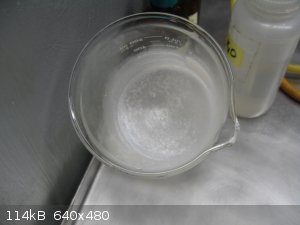
The single most important condition for a successful synthesis is good mixing - Nicodem
|
|
|
BromicAcid
International Hazard
    
Posts: 3266
Registered: 13-7-2003
Location: Wisconsin
Member Is Offline
Mood: Rock n' Roll
|
|
Nice to see this in action, I remember the flurry of activity on the forum when people first started dehydrating phosphoric acid realizing the
possibilities and then it died off just as quickly.
|
|
|
S.C. Wack
bibliomaster
    
Posts: 2419
Registered: 7-5-2004
Location: Cornworld, Central USA
Member Is Offline
Mood: Enhanced
|
|
Is Krytox a no, or did it just seem unwise? Pardon my dickness but I think if many people tried this, the glass would break on several. IMHO you could
be a little lucky the beaker didn't crack and it would be crazy to use it for anything ever again; the RBF is disposable too.
|
|
|
Magpie
lab constructor
    
Posts: 5939
Registered: 1-11-2003
Location: USA
Member Is Offline
Mood: Chemistry: the subtle science.
|
|
Quote: Originally posted by S.C. Wack  | | Is Krytox a no, or did it just seem unwise? Pardon my dickness but I think if many people tried this, the glass would break on several. IMHO you could
be a little lucky the beaker didn't crack and it would be crazy to use it for anything ever again; the RBF is disposable too. |
I badly wanted to use Krytox but assumed the SO3 would just eat it alive, carbonizing it, and seizing the joints worse. I assume that my present
joint seizings are due to carbon contaminants in the Rooto acid I used for joint grease.
Dickness has its place. This is the second time I've used these vessels for making oleum. Although I can't remove this scale I don't think it has
compromised the strength of the glass. Chemglass (apologies to Dr Bob) has especially thick walls. I will use these same vessels for my next run of
oleum.
The single most important condition for a successful synthesis is good mixing - Nicodem
|
|
|
Vosoryx
Hazard to Others
  
Posts: 282
Registered: 18-6-2017
Location: British Columbia, Canada
Member Is Offline
Mood: Serial Apple Enjoyer
|
|
Thanks for including the pics.
|
|
|
Magpie
lab constructor
    
Posts: 5939
Registered: 1-11-2003
Location: USA
Member Is Offline
Mood: Chemistry: the subtle science.
|
|
I reread the specifications on Krytox. I think this badass lubricant can handle the job and I will be using it next time.
[Edited on 25-11-2017 by Magpie]
The single most important condition for a successful synthesis is good mixing - Nicodem
|
|
|
nitro-genes
International Hazard
    
Posts: 1048
Registered: 5-4-2005
Member Is Offline
|
|
Nice write up!  How likely is cracking glassware during dehydration of the
phosphoric acid? In another thread I read something about copper being passivated, maybe adding a small amount of a copper salt can passivate
something like stainless enough to also do the dehydration (US2653177)? How soluble is the solid HPO3 in the sulfuric acid, can you also add the solid
HPO3 (it crumbles very easily) instead of pouring the hot melt directly into sulfuric? How likely is cracking glassware during dehydration of the
phosphoric acid? In another thread I read something about copper being passivated, maybe adding a small amount of a copper salt can passivate
something like stainless enough to also do the dehydration (US2653177)? How soluble is the solid HPO3 in the sulfuric acid, can you also add the solid
HPO3 (it crumbles very easily) instead of pouring the hot melt directly into sulfuric?
|
|
|
Magpie
lab constructor
    
Posts: 5939
Registered: 1-11-2003
Location: USA
Member Is Offline
Mood: Chemistry: the subtle science.
|
|
I have fired the same vessels several times now with no hint of cracking.
I don't thikn it matters how you mix them - you are going to heat the shit out of them anyway & they will mix.
The single most important condition for a successful synthesis is good mixing - Nicodem
|
|
|
nitro-genes
International Hazard
    
Posts: 1048
Registered: 5-4-2005
Member Is Offline
|
|
Thanks for the reply, had one cracking during distillation of sulfuric, not a pleasant thing (my cheapskate glassware maybe).
Maybe not appropriate to post here, but from the the patent mentioned above:
"It has been found that the attack by phosphoric acid on high chrome-nickel steels containing molybdenum is markedly decreased at acid concentrations
above about 100% calculated as orthophosphoric acid...
From the figure it is seen that as the acid concentration rises above about 95% and especially when it is above 100%, the rate of corrosive attack
decreased very rapidly as the acid concentration is increased"
So it seems that it is especially the partially dehydrated phosphoric is corrosive, maybe starting from diammoniumphosphate heating in stainless would
also work?
|
|
|
Bert
Super Administrator
        
Posts: 2821
Registered: 12-3-2004
Member Is Offline
Mood: " I think we are all going to die. I think that love is an illusion. We are flawed, my darling".
|
|
Quote: Originally posted by Magpie  | I reread the specifications on Krytox. I think this badass lubricant can handle the job and I will be using it next time.
[Edited on 25-11-2017 by Magpie] |
Did you try the Krytox? If so, which variety, what were the results-
Krytox LVP grease carbonized in the joints on a member during a sulfuric acid distillation, did he just choose an incompatible variety? There are
a lot of greases and oils available in that product line-
https://m.ebay.com/sch/i.html?_from=R40&_nkw=krytox&...
Rapopart’s Rules for critical commentary:
1. Attempt to re-express your target’s position so clearly, vividly and fairly that your target says: “Thanks, I wish I’d thought of putting it
that way.”
2. List any points of agreement (especially if they are not matters of general or widespread agreement).
3. Mention anything you have learned from your target.
4. Only then are you permitted to say so much as a word of rebuttal or criticism.
Anatol Rapoport was a Russian-born American mathematical psychologist (1911-2007).
|
|
|
Magpie
lab constructor
    
Posts: 5939
Registered: 1-11-2003
Location: USA
Member Is Offline
Mood: Chemistry: the subtle science.
|
|
I have not tried Krytox in this application yet.
Here's whats on the lable: Krytox GPL205
0.5 oz/D10170248
The single most important condition for a successful synthesis is good mixing - Nicodem
|
|
|
Waffles SS
Fighter
   
Posts: 998
Registered: 7-12-2009
Member Is Offline
|
|
That is great Magpie,
If you sure that you made pure HPO3 then it should be very interesting to test reaction of ACOH with it according to GB299342 patent
[Edited on 5-2-2018 by Waffles SS]
|
|
|
Bert
Super Administrator
        
Posts: 2821
Registered: 12-3-2004
Member Is Offline
Mood: " I think we are all going to die. I think that love is an illusion. We are flawed, my darling".
|
|
A gallon of 85% Phosphoric is sitting in our cleaning supplies. Used to clean up Aluminum pontoons on barges we shoot fireworks off of. Wonder if I
have a "disposable" grade piece or two of glass, but good enough not to fail before done doing this??
What is the best manufacturer of cheaper Oriental borosilicate labware these days? Had some Bomex, it was like paper.
[Edited on 5-2-2018 by Bert]
Rapopart’s Rules for critical commentary:
1. Attempt to re-express your target’s position so clearly, vividly and fairly that your target says: “Thanks, I wish I’d thought of putting it
that way.”
2. List any points of agreement (especially if they are not matters of general or widespread agreement).
3. Mention anything you have learned from your target.
4. Only then are you permitted to say so much as a word of rebuttal or criticism.
Anatol Rapoport was a Russian-born American mathematical psychologist (1911-2007).
|
|
|
JJay
International Hazard
    
Posts: 3440
Registered: 15-10-2015
Member Is Offline
|
|
The best is probably Laboy or Synthware. I've had very few problems with GG-17 flasks (Nanshin has a pretty good selection).
|
|
|
| Pages:
1
2 |